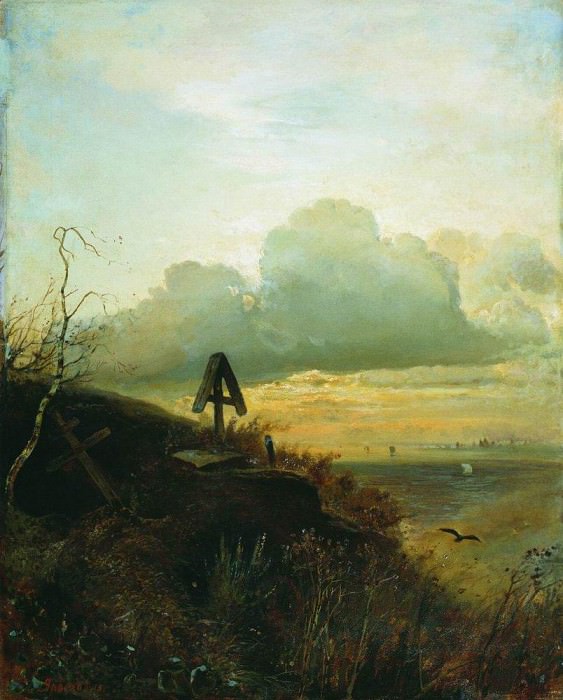Tomb of the Volga. Environs of Yaroslavl. 1874 Alexey Kondratievich Savrasov (1830-1897)
Alexey Kondratievich Savrasov – Tomb of the Volga. Environs of Yaroslavl. 1874
Edit attribution
Download full size: 804×1000 px (0,1 Mb)
Painter: Alexey Kondratievich Savrasov
1874; canvas, oil; 81.3×65; Altai Krai Museum of Fine Arts. One of the strongest paintings by Alexei Kondratievich Savrasov is The Grave on the Volga. It belongs to the period of the painter’s creative flourishing, and rightly occupies a place among the most recognizable paintings of the Russian school of the late nineteenth century. Critics have praised this work and called it a "landscape-poem," which contains an abyss of feelings and emotions, a wide emotional spectrum, conveyed through the chosen subject, composition, and colors.
Description of Alexei Savrasov’s painting "Grave on the Volga
1874; canvas, oil; 81.3×65; Altai Krai Museum of Fine Arts.
One of the strongest paintings by Alexei Kondratievich Savrasov is The Grave on the Volga. It belongs to the period of the painter’s creative flourishing, and rightly occupies a place among the most recognizable paintings of the Russian school of the late nineteenth century.
Critics have praised this work and called it a "landscape-poem," which contains an abyss of feelings and emotions, a wide emotional spectrum, conveyed through the chosen subject, composition, and colors. The combination of incredible craftsmanship and precision of the idea makes an indelible impression on the viewer. Isaak Ilyich Levitan was very fond of this painting and felt that the simplicity of "The Grave on the Volga" contained "a whole world of high poetry.
The landscape is executed in dark colors, but it doesn’t leave a oppressive impression, despite the sad sight of a lonely grave on the bank of the river. The foreground of the painting which catches the viewer’s eye first of all is as if submerged in shadow. A small bent holly birch, dry grasses, a wooden log cabin of the grave, standing apart from all the mundane, living. The very embodiment of sadness and loneliness, but the background contrasts sharply with this melancholy, creating an extraordinary impression. The bright sublime distance of the sky, the width of the river, gilded in the rays of the setting sun - with these strokes the artist as if to make it clear that earthly life is not finite. Sadness passes, and something more sublime and significant replaces the brief human existence.
Far away from the dark shore, where everything is dead and abandoned, a lonely bird flies away, striving for the high clear skies. This is how the human soul, free from earthly shackles, seeks eternal grace and peace. The painting depicting the gloomy last refuge evokes a sense of purification and emotional fulfillment in the viewer.
Кому понравилось
Пожалуйста, подождите
На эту операцию может потребоваться несколько секунд.
Информация появится в новом окне,
если открытие новых окон не запрещено в настройках вашего браузера.
You need to login
Для работы с коллекциями – пожалуйста, войдите в аккаунт (open in new window).




















You cannot comment Why?